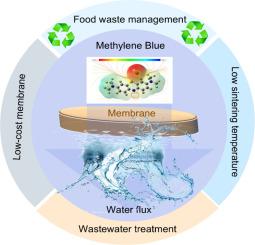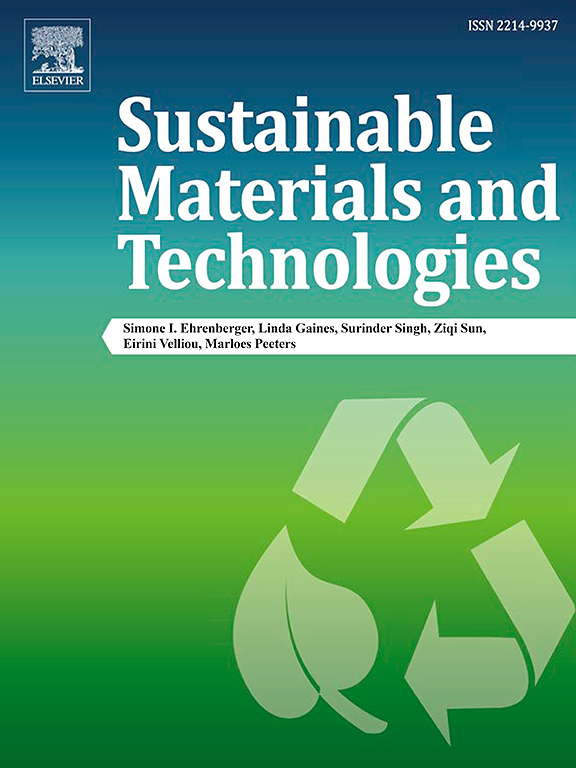Sustainable valorization of food waste into a pore-forming agent for ceramic membrane production: Experimental and DFT studies on methylene blue dye removal
IF 8.6
2区 工程技术
Q1 ENERGY & FUELS
引用次数: 0
Abstract
The increasing generation of food waste worldwide necessitates innovative solutions to limit environmental impact and optimize resource use. This research explores the potential of using food waste as a pore-forming agent into the main material, which is red clay to produce porous ceramic membranes as a sustainable approach. This membrane was investigated to see how effective it was at eliminating methylene blue (MB), a typical organic cationic dye, from industrial wastewater. The ceramic membranes were analyzed using various techniques, XRD, FT-IR, TGA, AFM, and a universal testing machine. The morphologies of the membranes were observed using SEM and elemental mapping. The optimized membrane containing 10 wt% of FW has a surface roughness of 162.5 nm, water permeability of 160 L h−1 m−2 bar−1, and could reject 79 % for MB. The membrane had a negative surface charge at the pH >5.37, while the pH of MB was 6.17, implying adsorption as the removal mechanism for the cationic dye, this has been confirmed by DFT calculations. The dye removal for 20 mg L−1 feed concentration was 79 % which increased to 86.1 % at pH = 10 and decreased to 74.26 % at the pH = 2. The total fabrication cost of this membranes is approximately 52.38 USD/m2, which is cheaper than the conventional membranes. The affordability of these ceramic membranes is attributed to the use of economical materials that don't need high sintering temperatures. The results of this research demonstrate that these membranes are both cost-effective and have favorable characteristics that make them suitable for water treatment purposes.

将厨余垃圾可持续地转化为用于陶瓷膜生产的孔隙形成剂:去除亚甲基蓝染料的实验和 DFT 研究
全球产生的食物垃圾越来越多,因此需要创新的解决方案来限制对环境的影响并优化资源利用。这项研究探索了利用食物垃圾作为孔隙形成剂,将其作为主要材料(即红土)来生产多孔陶瓷膜的潜力,这是一种可持续发展的方法。研究人员调查了这种膜在消除工业废水中典型的有机阳离子染料亚甲基蓝(MB)方面的效果。研究人员使用 XRD、傅立叶变换红外光谱、TGA、原子力显微镜和万能试验机等多种技术对陶瓷膜进行了分析。使用扫描电镜和元素图谱观察了膜的形态。含有 10 wt% FW 的优化膜的表面粗糙度为 162.5 nm,透水性为 160 L h-1 m-2 bar-1,对甲基溴的排斥率为 79%。膜在 pH 值为 5.37 时表面带负电荷,而甲基溴的 pH 值为 6.17,这意味着阳离子染料的去除机制是吸附,这一点已被 DFT 计算所证实。20 mg L-1 进料浓度下的染料去除率为 79%,pH = 10 时上升到 86.1%,pH = 2 时下降到 74.26%。这种膜的总制造成本约为 52.38 美元/平方米,比传统膜便宜。这些陶瓷膜之所以价格低廉,是因为使用了不需要高温烧结的经济型材料。这项研究的结果表明,这些膜既具有成本效益,又具有使其适用于水处理目的的良好特性。
本文章由计算机程序翻译,如有差异,请以英文原文为准。
求助全文
约1分钟内获得全文
求助全文
来源期刊

Sustainable Materials and Technologies
Energy-Renewable Energy, Sustainability and the Environment
CiteScore
13.40
自引率
4.20%
发文量
158
审稿时长
45 days
期刊介绍:
Sustainable Materials and Technologies (SM&T), an international, cross-disciplinary, fully open access journal published by Elsevier, focuses on original full-length research articles and reviews. It covers applied or fundamental science of nano-, micro-, meso-, and macro-scale aspects of materials and technologies for sustainable development. SM&T gives special attention to contributions that bridge the knowledge gap between materials and system designs.
 求助内容:
求助内容: 应助结果提醒方式:
应助结果提醒方式:


